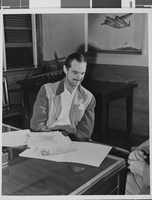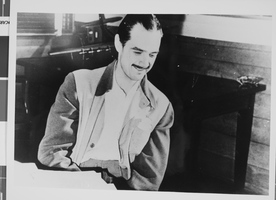Search the Special Collections and Archives Portal
Search Results

Photograph of Howard Hughes, circa 1938
Date
Archival Collection
Description
Image

Photograph of Howard Hughes and Earl Martyn in the cockpit of the Hughes Flying Boat, Los Angeles Harbor, 1947
Date
Archival Collection
Description
Image
Howard Hughes Public Relations Reference Files
Identifier
Abstract
The Howard Hughes Public Relations Reference Files (1931-1997) were compiled by Richard "Dick" Hannah, vice-president of the Los Angeles public relations firm Carl Byoir & Associates, which was hired to direct public relations for Hughes’ companies. The collection is primarily composed of newspaper clippings organized into reference files. A significant number of the files contain articles about Howard Hughes’ personal life, the operations of his companies, and legal and political disputes involving Hughes and his companies. The files also document a range of other subjects related to his business ventures, including aviation, aerospace, defense industries, motion picture studios, film stars, communism in Hollywood, and the House on Un-American Activities Committee (HUAC). Later in life Hughes became obsessed with how he was being portrayed in the media. In addition to collecting magazine articles, newspaper clippings, transcripts, screenplays, and books that referenced him. He also collected newspaper clippings about the activities of print media outlets, columnists, radio-television stations, current and former employees, and competitors. The collection also contains newspaper clippings about Watergate, organized crime, gambling, and Las Vegas and contains press releases, correspondence and records generated by Carl Byoir & Associates as well as Rosemont Enterprise, Inc.
Archival Collection

Photograph of Howard Hughes, circa 1937
Date
Archival Collection
Description
Image
Allison and Hugh Wallace oral history interview
Identifier
Abstract
Oral history interview with Allison and Hugh Wallace conducted by Claytee D. White on March 17, 2006 for the Hurricane Katrina Survivors in Las Vegas Oral History Project. In this interview, the Wallaces relate their upbringing, families, and educational attainments. Later, they talk about their experiences with Hurricane Katrina, evacuating and then returning to find their neighborhood overrun with looters and their home severely damaged by the flooding. They discuss the extreme difficulty they faced finding money and resources as they faced loss of employment, housing, and access to their bank accounts. They also describe the emergency relief efforts of various state, national, and federal agencies. Finally, they relate that these difficulties led to their decision to move to Las Vegas, Nevada and comment on the difficulty of maintaining contact with friends and colleagues who also left Louisiana.
Archival Collection

Map showing U.S. Bureau of Reclamation Region 3 projects in Arizona, California, Nevada, New Mexico and Utah, September 1967
Date
Description
Image

Photograph of Howard Hughes, circa 1947
Date
Archival Collection
Description
Image

Photograph of Howard Hughes, circa 1947
Date
Archival Collection
Description
Image

Photograph of Howard Hughes, circa 1947
Date
Archival Collection
Description
Image
Hughes Aviation
Level of Description
Archival Collection
Collection Name: Frank Mitrani Photographs
Box/Folder: N/A
Archival Component
